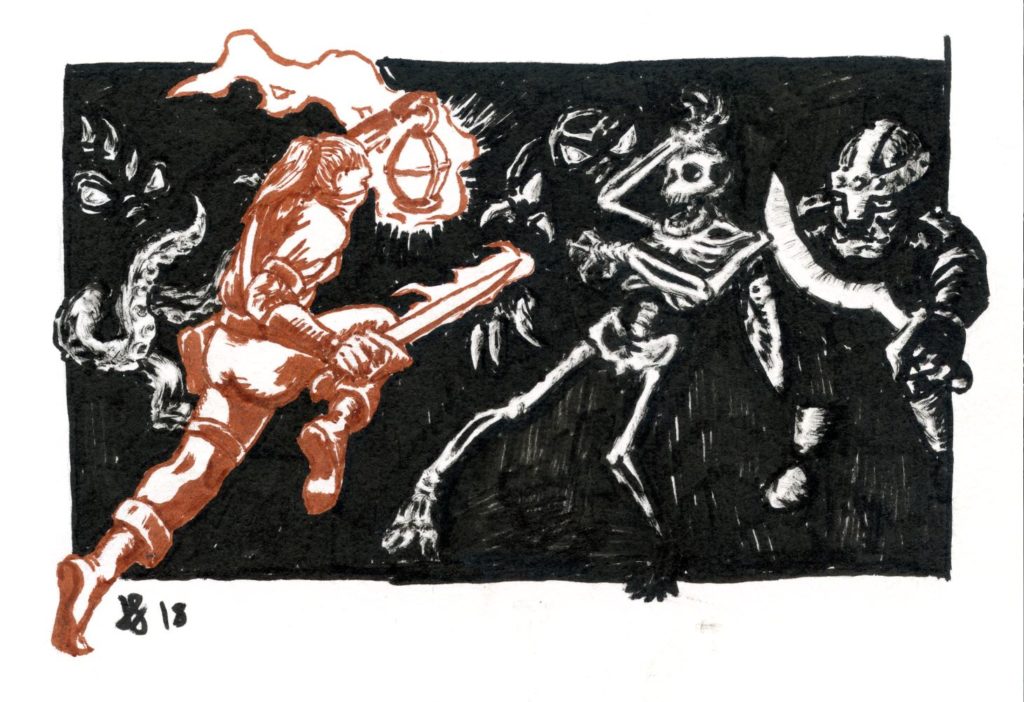Finding the Excitement
So far our big games have mashed up genres I love (space opera) with systems that suit them well. In a way, that’s cheating—it’s low hanging fruit in the inspiration game. But what happens when you can’t do that? How do you tease your imagination to spin a game out of something other than thin air?
I’m always impressed with designers who can make a game out of almost anything. I’ve seen Jason Morningstar of Fiasco fame make games about topics ranging from praising an ancient emperor, being translators in a war zone, the Fast and the Furious movies, and the siege of Leningrad. My friend Luke wrote a game inspired by Cornish Shipwreckers (check it out here). It’s a serious skill to spin a playable (and fun!) game out of an article you’re reading.
Inspiration is fickle. It might strike out of the blue and show you the shape of a whole game in a single moment. While this might happen, there is no way to predict it. So what do you do when you aren’t suddenly hit by a muse? Or much more likely … what happens when you only have a loose idea or just a few pieces you want to weave together?
That Unreliable Muse
A friend of mine made a few small pieces of art every week while waiting for an appointment. Because of resource constraints, he used two brush pens to make these drawings (one black, one orange). The result were some absolutely stunning pieces that whispered to me of old roleplaying games from my childhood.
“These need a game to go with them,” I said.
“Well do you want to write one?” he asked.
I was inspired! I knew the feeling I wanted to capture. That Halloween adventure where kids would nibble on candy and make scary monsters. The nervous giggles in a tent lit only by a few flashlights, and kids trying to come up with clever ideas for extra dice. Great! How do you get from there to a game?

Finding that Excitement
One of the tricks I use is to find the thing in a design I’m excited about. This doesn’t have to be a single thing:
- I decided to try and condense the core system onto one page. This keeps the scope of the project reasonable. Why is this exciting? I’ve seen a number of Forged in the Dark hacks, but they tend to cleave very close to the original. I wanted to provide a simplified, stripped down, tiny version of the game as a small, lightweight building block to build from. Is this inspiration? No. But it is exciting! At least to me.
- I wanted to have an interesting world. I never understood dungeons (really who would build such a thing? And why?). So I came up with my own “dungeon concept”. Sticking with the theme of kids telling scary stories in the dark, I made up a world covered in darkness, where the darkness itself creates monsters. Now adventurers delve into the everyday, but seen through the lens of kids in the dark, spotting monsters around every bend.
- I wanted to have weird STUFF! One of the joys of games I remember from my childhood is reading through lists of gear and it igniting my imagination. Similarly, recently I find similar joy still in things like artifact lists from Into the Odd (great game, check it out here). So I gave myself the task to come up with some fun and weird gear to describe this world.
When you don’t get a whole system in a bolt of inspiration, excitement will often do. Figure out what you’re excited about and by, and see if it’s enough to keep the project rolling. Once you have enough “bits,” filling in the gaps becomes a mechanical process. Do you need loot? Try a few systems and see what works. I was excited to make loot stuff you have to drag back to town, which you might have to drop other stuff to carry. Do you do it? Ooh, tough decisions.
Just a Few Pieces
Let’s look at another practical example. Recently I agreed to make a game for a convention a friend of mine is putting together. The catch was—folks who supported it would get to tell me what to write. For Into the Dark I had a feeling, and some inspiring art! Here I just got 3 words: trust, spy-craft, and supernatural. That’s not a whole lot to work from.
Working Towards Inspiration
Sometimes the things you’re excited about are not tied directly to the topic at hand. One of the things I had seen that I was excited about was ashcans. An ashcan—in case you’re unfamiliar—is a term originally from comics. Comic artists/writers would make small booklets as a proof of concept, and so they could copyright an idea. In RPGs it was a popular format for indie games. Designers would make small booklets in order to see if folks would be willing to bite on the game. They tend to be cheaper than finished games, but are a bare-bones playable format. I spotted my first ashcan around 2007, but they’ve been making a bit of a comeback recently, and I really wanted to give one a go.
Now a format is useful. Knowing the format I knew my page size. This gives me a sense of chunks I can write rules in, and a way to break up the text. If you think about a book, two pages are a spread—a self contained visible unit. In general for ease of reference and use, I tend to contain a concept (or a small group of related concepts) within the same spread. It helps the reader chunk up the information. It helps reference a single spot to get a whole concept. And it helps me write an outline in a series of 2-page spreads.
Next Steps
But a format isn’t enough. I needed some bits of the system to get excited about. It took me a bit to land on something.
I was discussing spy genre movies, and what makes them exciting with my co-designer.
“Everyone wants to be James Bond,” he suggested. “It’s fun to be charming, suave and a bad-ass. Classic power fantasy.”
“Actually,” I said figuring out an important piece. “I always wanted to be The Guy in the Chair.” Oracle to Nightwing/Batman. Ned to Spider-man.
This formed a core component of mechanics. We’d have asymetric, paired play. One person would be the superspy, the other a handler. Asymetric mechanics are always fun. This also suggested a system! We landed on a Powered by the Apocalypse hybrid (where the spies and handler have different sets of base moves).
We also spent some time discussing tone, and landed on the mistrust of the system themes of Ghost in the Shell: Standalone Complex, but replacing cyberware with magic. Excitement? Now through the roof.
A Few Final Thoughts
Most people believe that design is mostly inspiration, but while inspiration can strike there is a skill to piecing together a game when it doesn’t. Learning how to find what excites you and use that as the cornerstone building blocks to make a game about a topic is a skill that can be practiced and honed like a muscle.
The next time inspiration is fickle give it a go. Delve deep. Find what excites you about a concept (layout, mechanics, thematic elements) and follow that through to the end.

